First sneak preview of Logframer 2.0
It's been quiet around here lately, but don't let that fool you. During the last months I've been very busy with the brand new Logframer 2.0. As I've announced previously, this version is a major upgrade to Logframer 1.x, with all new features as well as a major overhaul to improve performance.
But enough chit-chat, how about some screenshots?
Managing the logframe with ribbons
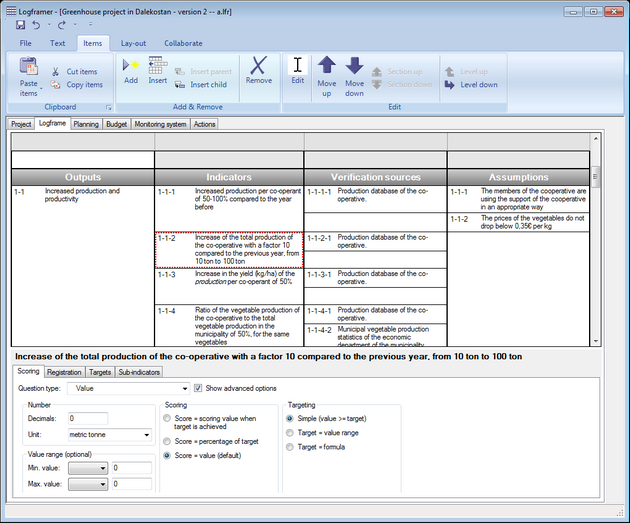
Tadaaaah! How about a round of applause folks?
You'll immediately notice the familiar logical framework in the centre. Although at first glance it looks much the same, it has some nifty new features. And now it is lightning fast too, thanks to a completely new rendering engine.
Near the top you can see that Logframer now has a MS Office-style ribbon. The content of the ribbon changes according to what you are doing, as you would expect from a ribbon.

With the lay-out tab you can control what elements are visible in your logframe. You can show or hide columns, as usual, but now you can also show/hide the different sections of the logframe. There is a new button to show the whole logframe at once, or hide everything but the purpose(s).

This is the Items ribbon tab. On the left you can see the various copy/paste options. The cut-copy-paste mechanism has been greatly improved, making it amongst other things easier to copy text from other applications, or copy/paste groups of items and so on. Next to the Add and Insert buttons, you can see the Insert Parent and Insert Child buttons...
Child activities and child indicators
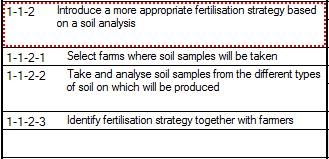
... because now you can add child-activities and child-indicators. You can add as many levels as you like (I tried up to 12 sub-levels in practice).
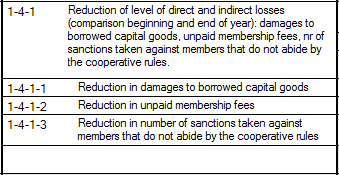
Advanced options to develop your monitoring and evaluation system
Talking about the indicators, these have had a major revision too. Not only can you create compound indicators using the sub-indicators; the way that you can add up the values or scores of the indicators has had a major update. For instance, you can use the values that are registered directly, or replace a certain value range with a score.
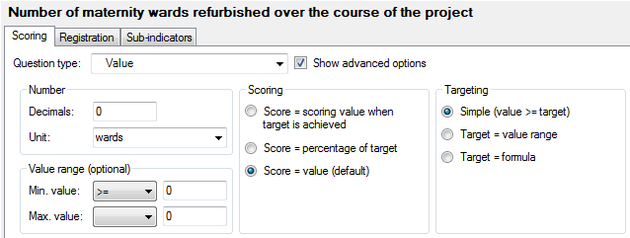
Below you can see how the total value of a main indicator is calculated based on the values of its sub-indicators. This is just an example of the 'values' type of indicator, but in total there are sixteen different types of indicators, all of which can use sub-indicators.

Another new feature that you may have remarked in the image above is that it is now possible to identify multiple targets (instead of just a single target in the current version of Logframer). For each section in the logframe (goals, purposes, outputs and activities) you can determine at which intervals indicators have to be monitored:
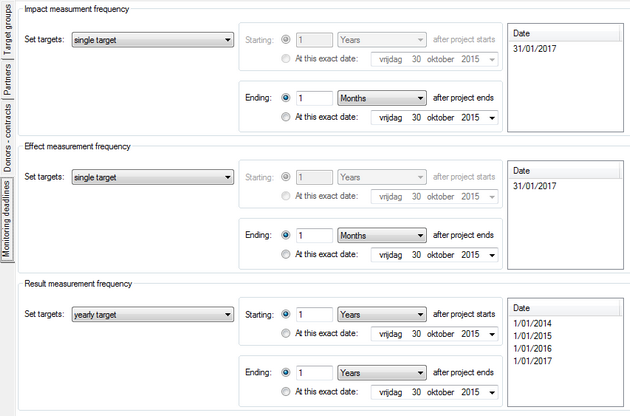
For instance, you can specify that impact (goals) and effect (purpose) indicators anly have to be monitored at the end of the programme, while the output indicators have to be measured yearly. Also, for every indicator you can measure a baseline.
RAID
Jumping to the last column, the Risks detail window will look familiar to you. However, I now integrated the RAID-typology, which stands for 'Risks - Assumptions - Issues - Dependencies'.

So when you select Assumptions you can complete the following information:

And this is the Dependencies window:

For each type of RAID element you can identify how you will deal with it (over time) and how it may influence your programme.
Project overview page
In Logframer 1.x, you would get a single overview of the logical framework with the details section in the bottom and a pop-up window showing the project's planning. In version 2.0 you can use different tab pages to see the various main elements of your programme. The logical framework has its page of course, and via the details window you can still see different information about your project. But the first page you'll see when you open the application is the Project overview, withe the project's title, its duration and other info. Below it you can immediately see who will benefit from the project, in the overview of the target groups. Other tabs allow you to register partners, donors, etc. On this page you also find the monitoring options that we saw above (when - intermediary - targets have to be reached and monitored).
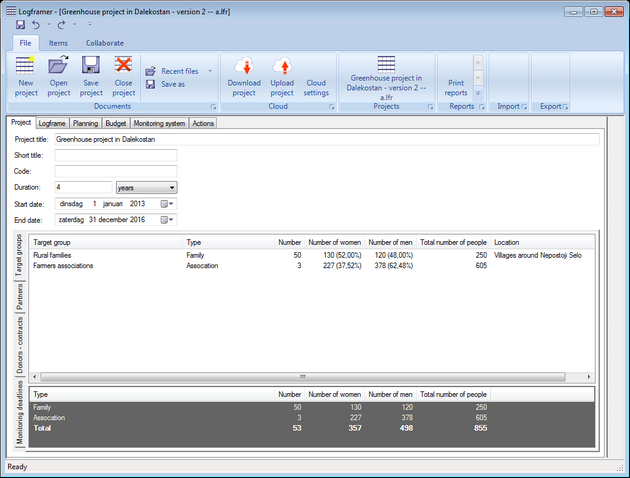
The Planning window also had a major overhaul. In version 1.3, the Planning pop-up window just gave a static overview of the key-moments and activities that you identified using the logframe and the detail window. In version 2.0, the planning is now fully interactive, up to the point that you can design a project just like you would in Microsoft Project, using Gantt charts rather than the logical framework. I'll show you how it works in a follow-up post.
Simple or multi-year budget
Also new in this version is the inclusion of the project's budget:
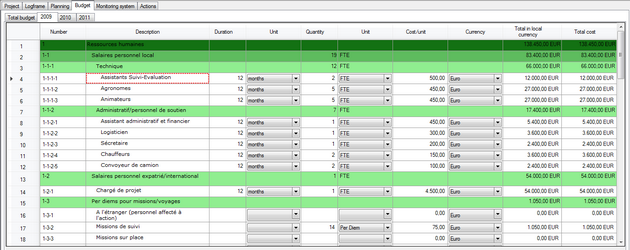
You have the choice between working with a single page budget for the whole of your project, and establishing a multi-year budget. In that last case, you create the main budget headings on the overview page, and then you can specify year by year what specific costs (budget items) you want to include.
For each budget item you can calculate its cost based on how many times you will need it (in terms of duration), how many items you need and how much a single item costs (optionally in local currency). At the left you can see the totals in local currency (should you need this) and in the currency of the budget.
The totals for each budget heading are then summed up on the 'Total budget' page:
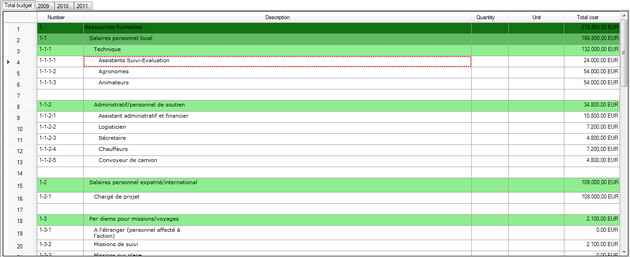
Back in the logframe, once you've established your project's budget you can use it to indicate for every activity how many resources you will need:

You make (indicative) totals by selecting budget items and then you can specify what percentage of that cost will be needed for the activity in question.
Almost there, but not quite
So far the development of version 2.0 has progressed quite well - I've even been working on elements for later versions. But on the other hand there's still quite a bit to do before I can release version 2. Amongst other things, I have to update the printing and import/export modules to use the new rendering engine and accomodate for the new features such as the child activities/indicators and the new budget. The Undo/Redo module also needs an upgrade and then there's all the work of translating the interface and creating or updating the help files as well as the website. At the moment I'm aiming for April or May next year to release Logframer 2.0.


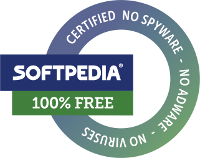
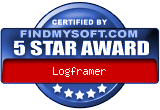

Commentaires
Round of applause
It looks really great, can't wait to see the new release!
Mono
This looks awesome indeed!Can you please also try to ensure MONO compatibility so that it will run on Macs and Linux as well?If you release a alpha I am willing to test it and send you the error log if needed.
NoMono
I've been playing around a bit with Mono myself and it seems we've hit a snag: Logframer is written in VisualBasic.net and Mono only supports C#. I guess I could do a port to C# (there are automatic translators available but they are not always reliable) but that would mean a lot of work. I've never counted how many lines of code there are exactly, but there's been a dramatic increase in size between Logframer 1.3 and 2.0
Looks like it is supported
According to this page Mono does support visualbasic.net though:http://www.mono-project.com/docs/about-mono/languages/visualbasic/
Add new comment